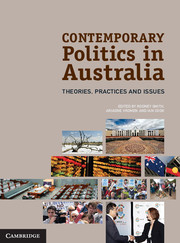Book contents
- Frontmatter
- Contents
- Tables and figures
- Contributors
- Acknowledgements
- Introduction
- I Contemporary Theories of Australian Politics
- Part II Politics in Everyday Australian Life
- Part III Elections
- Part IV Participation and Representation
- Part V Inside the Australian State
- Part VI Contemporary Public Controversies
- Introduction to Part VI
- 25 A Bill of Rights
- 26 Spending and taxing
- 27 Employment and education
- 28 Cities
- 29 Indigenous Australians
- 30 Health
- 31 The environment
- 32 Australia in the world
- Glossary
- References
- Index
Introduction to Part VI
from Part VI - Contemporary Public Controversies
Published online by Cambridge University Press: 05 June 2012
- Frontmatter
- Contents
- Tables and figures
- Contributors
- Acknowledgements
- Introduction
- I Contemporary Theories of Australian Politics
- Part II Politics in Everyday Australian Life
- Part III Elections
- Part IV Participation and Representation
- Part V Inside the Australian State
- Part VI Contemporary Public Controversies
- Introduction to Part VI
- 25 A Bill of Rights
- 26 Spending and taxing
- 27 Employment and education
- 28 Cities
- 29 Indigenous Australians
- 30 Health
- 31 The environment
- 32 Australia in the world
- Glossary
- References
- Index
Summary
Fully appreciating the nature of a political system requires understanding the theories (Part I), political culture (Part II), institutions (Part III), processes and practices of participation (Part IV), as well as the major political institutions (Part V) that are expressed and reflected in that system. But to understand that system fully requires seeing it in action. For the role of political systems is to produce collective responses to issues that confront, and usually divide, members of society, and to do so in ways that do not result in social breakdown. To do this, we move to discussions of various issues addressed, or not addressed, through and by the Australian political system.
All but one of the issues discussed in this chapter have long been acknowledged and addressed through Australia’s political system. The exception is city policy, which Brendan Gleeson and Wendy Steele argue has never been dealt with adequately through the Australian political system (Chapter 28). This does not mean that the issues faced by cities have not confronted policy-makers in Australia; rather, these issues have not been approached in a consistent and systematic way. A lack of concerted interest on the part of successive Commonwealth governments has combined with an absence of processes that would allow urban policy issues to be dealt with consistently and systematically to produce a policy vacuum. A contemporary aspect of this is that now-dominant neo-liberal approaches to governing make a major contribution to maintaining this vacuum.
- Type
- Chapter
- Information
- Contemporary Politics in AustraliaTheories, Practices and Issues, pp. 284 - 285Publisher: Cambridge University PressPrint publication year: 2012



